|
|
Post by codystarbuck on Jun 25, 2019 11:53:56 GMT -5
Well, according to Mark Gruenwald, they just add or subtract mass from/to other dimensions. That was the stock answer for anyone's powers/size. Cyclops' eye beams? Eneergy from another dimension. Hulk's mass? Other dimension. Wolverine's body hair? other dimension.
Well, maybe 2 out of 3.
|
|
|
|
Post by Roquefort Raider on Jun 25, 2019 16:43:34 GMT -5
I meant to comment on this one earlier; when Cap wakes up, he thinks Fury is a fake, because he knows the highest ranking African-American in the US Army and he isn't a general. Millar must not of done any research, at all, or we will have to pass it off as wonky Marvel alternate history. The highest ranking African-American in the US Army, in WW2, was Benjamin O. Davis, who was promoted to the rank of Brigadier General, in 1940, before the US entry into WW2. His son, Benjamin O. Davis Jr commanded the 332nd Fighter Group, aka The Tuskegee Airmen (as a colonel), and was later promoted to Brigadier General, in 1954 (temporarily, but it was made permanent in 1960). He was ultimately promoted to 4-star General, in 1998, while retired. I remember reading that issue, the day I picked it up from my LCS and growling out loud, "Gen Benjamin O Davis! Read a book, Millar!" That’s extremely interesting, and I’m surprised Millar didn’t check his facts before tossing that line. (I personally had no idea, and given the segregated nature of the armed forces during WWII, took Cap’s word for it.) It was indeed not a difficult thing to research, even in the early days of the internet. (I give Millar a pass for not going to the library, as I don’t know how many books on the composition of the United States’ armed forces there might be in a typical British public library. Not many, I would guess). In hindsight, given how few African American high ranking officers there were in 1945, Cap’s comment would have worked had he said “I know all the black generals in the U.S. army, and none of them is named Fury”. It would still have dated Cap and shown how he was still steeped in the segregation culture, without the historical error. |
|
|
|
Post by The Captain on Jun 25, 2019 17:02:39 GMT -5
Here's my issue with Cap, which is writ large in Ultimates; but spilled over into the regular comics: Cap was the epitome of a finesse fighter, from Simon & Kirby on up. He used skill, speed, technique, and agility to take out his opponents. He rarely resorted to brute strength. That's what made him stand out, to me. Here was a guy who used strategy and went after vulnerable points, used leverage, etc. It seems like writers and artists, from the 90s onward just steroided Cap up (both in the depiction of his abilities and his physical appearance) into a bruiser, rather than a fighter. Ultimates does employ a bit of strategy from Cap; but way more punching in the face fighting than you would expect of a Cap. Thankfully, the movies seemed to understand that a finesse Cap looks way cooler on screen. Compare to this Kirby sequence, from Tales of Suspense...   Now, Kirby uses Cap's strength, which is at the height of human ability; but, he uses skill just as much, to make his opponents wear themselves down and maneuver into a position where he can quickly take them out. In all aspects, Cap is a soldier and soldiers learn technique and strategy in fighting. The good ones rarely go for a full frontal assault, if sneaky can accomplish the job. I think some of it is a generational thing. Kirby's generation knew a bit about fighting (Kirby on the streets and the battlefield), especially the veterans of the war, while later generations rarely even got into playground scuffles. It seems like a lot of them have been conditioned to think that brute strength and force will win out, rather than speed, skill and precision. The athletes of today are packed with steroids, whereas those of Kirby's age had more skill and experience on their side, than science. Having never read The Ultimates, I can't speak to how Cap's fighting style was handled there, but you hit the nail on the head with how Kirby drew it. Cap was fluid, agile, almost-gymnastic in his style, using judo-esque moves to utilize his opponent's size and momentum against him. Sure, he would throw a punch when he needed to, but Kirby showed Cap to be graceful in the way he dispatched foes, not just a brawler beating opponents through sheer strength. |
|
|
|
Post by codystarbuck on Jun 25, 2019 22:06:06 GMT -5
Here's my issue with Cap, which is writ large in Ultimates; but spilled over into the regular comics: Cap was the epitome of a finesse fighter, from Simon & Kirby on up. He used skill, speed, technique, and agility to take out his opponents. He rarely resorted to brute strength. That's what made him stand out, to me. Here was a guy who used strategy and went after vulnerable points, used leverage, etc. It seems like writers and artists, from the 90s onward just steroided Cap up (both in the depiction of his abilities and his physical appearance) into a bruiser, rather than a fighter. Ultimates does employ a bit of strategy from Cap; but way more punching in the face fighting than you would expect of a Cap. Thankfully, the movies seemed to understand that a finesse Cap looks way cooler on screen. Compare to this Kirby sequence, from Tales of Suspense...   Now, Kirby uses Cap's strength, which is at the height of human ability; but, he uses skill just as much, to make his opponents wear themselves down and maneuver into a position where he can quickly take them out. In all aspects, Cap is a soldier and soldiers learn technique and strategy in fighting. The good ones rarely go for a full frontal assault, if sneaky can accomplish the job. I think some of it is a generational thing. Kirby's generation knew a bit about fighting (Kirby on the streets and the battlefield), especially the veterans of the war, while later generations rarely even got into playground scuffles. It seems like a lot of them have been conditioned to think that brute strength and force will win out, rather than speed, skill and precision. The athletes of today are packed with steroids, whereas those of Kirby's age had more skill and experience on their side, than science. Having never read The Ultimates, I can't speak to how Cap's fighting style was handled there, but you hit the nail on the head with how Kirby drew it. Cap was fluid, agile, almost-gymnastic in his style, using judo-esque moves to utilize his opponent's size and momentum against him. Sure, he would throw a punch when he needed to, but Kirby showed Cap to be graceful in the way he dispatched foes, not just a brawler beating opponents through sheer strength. They give him the agility; but, he tends to be more direct in his fighting and they upped his strength level, to where he is slugging it out with the Hulk. Now, yes, the Hulk situation is a direct result of trying to duplicate the Super Soldier Formula; but, he doesn't recreate it, just a variation, turning Banner into the Hulk. At first, it is temporary; but, after he takes the formula again, the Hulk cells become permanent. So, it is something other than what transformed Cap, creating something more powerful, supposedly. But, here, Cap takes him down (granted, after using a tank). It is more brute force than strategy and technique. Now, he fights Hank, at one point (as I recall, been a while) and is able to use his speed and agility to attack Hank's weak points.. It's kind of uneven. I liken it to how he has been drawn since the 90s. Up until Kirby's style morphed into the blockier, impressionistic look, Cap was built like a gymnast, with a bit of a pro wrestler look. By the 90s, everyone was drawing him like a pro wrestler; a roided up pro wrestler. he was bigger than everybody but the Hulk. A lot of storytellers followed Ultimates by having him match the power levels seen there. Fine, it's an alternate universe; but, I think it robs Cap of what made him more unique. He was a guy whose body was at the peak of human perfection and he used it like a surgical instrument. It's far more interesting seeing him deal with the Hulk, without being able to trade punches and have to rely on speed and leverage, and strategy to keep Hulk off guard and use his own strength and positioning against him. CATFA struck a pretty good balance with that, emphasizing Steve using his brains, before and after he got the body. Before, he gets the flag by solving the problem creatively, rather than physically, and after, he learns to use his strength and speed to attack multiple targets and keep them off guard. I do wish they had done a bit of research and hap portray Combato, the hybrid fighting style developed by Bill Underwood and taught to groups like the OSS and US and Canadian Law enforcement,. It was a mix of jiu jitsu, boxing, wrestling and street fighting tactics, which had more practical military application, in a combat environment. Underwood demonstrated his techniques on the Tonight Show and Real people and was throwing much younger people around like rag dolls. I'm sure plenty of people were fine with Ultimate Cap; and, for the most part (still don't like some of the political touches) so was I. It just was a bit of a disappointment and an area where I thought Millar's tendency to excess was weakening a pretty darn good story. it didn't derail it; but, it kind of disappointed me. Then, the Hank and Jan and Pietro and Wanda stuff got so off-putting, I stopped reading, until it was completely collected. Millar seems to have a problem of recognizing when he is going too far, for my money. In later comics, we will learn the origin of the research into the Super Soldier Formula, which will include ties to Nick Fury and Wolverine, in the Ultimate Universe. That was an interesting idea, though it did start to feel like way too much was being connected to singular events, rather than some things arising from other stimuli. The movies seemed like they were going in that pattern, at first; but, thankfully, diverged enough to keep it interesting. |
|
|
|
Post by Roquefort Raider on Jun 26, 2019 5:46:03 GMT -5
“How far can you go” seemed to be the modus operandi with this series, as it usually is with blockbuster movies.
How incestuous can Pietro and Wanda look? How many recognizable sites can we blow up? How brutal can the Hulk be? How many pop culture references can we have? How violent can the Pyms’ domestic life get? How eccentric can Tony appear? How badass can everyone be?
Part of the reason the Millar volumes worked for me is that strangely enough, that formula made for quite the page turner. I could have done without a few cringe-worthy elements, but overall it felt like a rollercoaster ride.
Regarding Cap: my favourite version is neither super strong nor even an undisputed master of hand-to-hand combat... he’s an athletic gymnast whose main quality is that he never gives up. Sure, he’s got skills... but I wouldn’t feel it wrong for him to have a hard time handling other skilled fighters. After all, Steve had very little time to actually learn how to fight after he received the super soldier treatment.
|
|
|
|
Post by wildfire2099 on Jun 26, 2019 6:43:35 GMT -5
I never really got into Ultimates.. .it seems to just be created solely for shock value... I definitely much preferred the other Ultimate titles.
One thing I always though was weird... why do they draw Wasp as Jubilee?
|
|
|
|
Post by rberman on Jun 26, 2019 8:17:08 GMT -5
I liken it to how he has been drawn since the 90s. Up until Kirby's style morphed into the blockier, impressionistic look, Cap was built like a gymnast, with a bit of a pro wrestler look. By the 90s, everyone was drawing him like a pro wrestler; a roided up pro wrestler. he was bigger than everybody but the Hulk. Multiply that thought by 100x, and you have my reaction to how Batman is often rendered in recent years. Compare these images from Detective Comics #27:  Detective Comics #227:  Detective Comics #427:  And Detective Comics #1000 (There was no #927 due to New 52 renumbering, and #827 featured Nightwing and Robin.)  Frank Miller's over-the-top version in The Dark Knight Returns appears to have been an unwholesome influence in this respect.  |
|
|
|
Post by codystarbuck on Jun 26, 2019 9:38:33 GMT -5
^^^Yeah, I would agree with that.
I think a lot of it has to do with generational differences. Earlier artists drew from sleeker models and more realistic inspirations: comic strips, pulps, sports, movies, etc. The pulps and comic strips were exaggerated; but, the heroes looked like the athletes of the day; muscular, but not massive. They also had circus performers as models, as circus was a bigger part of mass entertainment. So, you had more acrobatic builds and the strangman look.
As generations drew inspiration from comics, it seemed to feed on itself. Muscles became more pronounced and action sequences more fantastic. Also, science modified the look of athletes, with steroids allowing workouts to produce more detailed and bulkier muscles. Hollywood started to get involved with steroids, too, both in hiring guys like Arnold and in actors working out with trainers who taught them to cycle, to get more out of their workouts. Also, Hollywood actors learned to use steroids as fat burners to try to fight natural aging. It spilled over into the modeling world, too, especially the guys (but also women).
I've also heard a lot of the Image guys and those that followed use action figures as models and action figures, in the wake of He-Man and modern pro wrestling & bodybuilding, grew heavily distorted.
It makes sens that acrobatic heroes would have sleeker bodies, as they need the flexibility. Big muscle mass should appear more on strength-based characters, as they are using more muscle strength. Characters with special powers that aren't physical have no need for anything other than an average physique.
I can justify Frank Miller's Batman as reflecting Bruce's middle age and 10 years away from things. He wasn't doing the same things and probably stopped working out for fighting. Middle age slows the metabolism, so he tended to turn bulky, even if he wasn't paunchy (like Miller would give a hero a paunch). It made sense, in a certain light. It doesn't when Batman is starting his career or in his prime. Artists like Jim Lee can't seem to render acrobatic physiques, because their models are all bulkier NFL players, pro wrestlers or bodybuilders, or toys based on such people. The generation before, like Byrne & Perez, were drawing from different influences, with more realistic and more varied body types. They followed guys like Adams, who drew muscular, yet sleeker figures. Even Kirby wasn't portraying bulkier figures, until the 70s (well, late 60s into the 70s) and even Kirby, in that phase, tended to draw them sleeker, in non action scenes, and bulkier in action, in certain angles. If you look at New Gods, Orion is heaviest when he is in the foreground, fighting or smashing through thing. if he is standing there, running, or swooping around, he is sleeker. Same with the 70s Cap, Ikarus, Mark Shaw Manhunter, Black Panther and OMAC.
|
|
|
|
Post by Roquefort Raider on Jul 1, 2019 10:26:10 GMT -5
The Ultimates Volume 1 Story by Mark Millar Art by Bryan Hitch and Andrew Currie, colours by Paul Mounts Chapter six : Giant Man vs The WaspThis issue uses an interesting canvas: the sharp contrast between two relationships. One of which is very unlikely but might be the start of a beautiful friendship, while the other should be bliss but turns out to be violently toxic. The plot in a nutshell: after the trauma of facing the Hulk and witnessing the death of almost a thousand innocents, the Ultimates are supposed to meet for dinner at Tony’s place. While Stark, Steve Rogers and Thor bond, Jan and Hank have a vicious fight… the culmination of years of domestic violence, as we are made to understand. It could simply be seen as the infamous “Hank slaps Jan” scene from Avengers #213 amped up for the Ultimate universe, but it is actually a pretty accurate rendition of how domestic violence can be a part of what appears to be, for outside observers, an ideal marriage. It is also very graphic, something that in the wrong hands could be akin to unhealthy voyeurism but here rightly shows the horror of such a situation. Chapter 6 starts by taking stock after the dramatic events from the previous issue. Bruised and battered, Bruce Banner is in a Hulk-proof cell (the same one that we will see in the first Avengers movie.  We are shown the cynicism slash practical nature of SHIELD, as a disaster caused by the super-hero initiative is turned into a great public relations opportunity: instead of being presented as the unwitting cause of the Hulk disaster, the Ultimates are only shown as the heroes of the day. They become immensely popular, which was, ironically enough, Banner's plan all along.  This PR operation means that Jan gets to be featured on several talk shows, where she jokingly mentions (accurately, as it turns out) that her husband’s pummelling at the hands of the Hulk battered his ego more than anything else. This flippant remark will have dire consequences. Tony invites his teammates for dinner, and as Thor and Cap are the first to turn up, they form quite an unlikely trio; the points of a triangle, as it were. Stark is the chaotic billionaire, Thor is a chaotic working class dude, and Cap is a very disciplined working class fellow. They should not get along, but Stark and Thor become quick friends (as they were in the regular Marvel Universe, once upon a time) while Cap is certainly mellower toward both of them than I would have expected. When Jan and Hank fail to appear, the three of them eat and discuss a few things. Thor will not join the Ultimates but is ready to help in case of real need; Cap is uncomfortable with hiding the fact that Banner and Hulk are the same person, and Tony is getting rid of his belongings… because he suffers from an inoperable brain tumour, and he wants to give back all he can to the world while there’s still time. That’s an aspect of what I really like in The Ultimates and the approach Millar chose for it: it is not just a rebooting of the Avengers meant to go on forever (or of it is, that’s not how it reads) but it feels like a story with an ending in sight, not too far in the future. Tony has five years to live, tops. 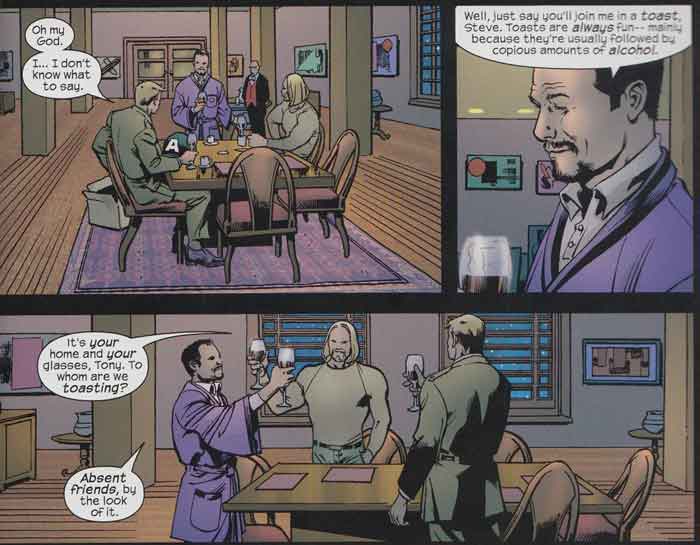 The other two are naturally shocked by the news, and Stark alleviates the mood by presenting Cap with an item from his many collections: his old helmet, last seen in issue, #1, and picked up at the time by Kowalski, the soldier who claimed to have no faith in Captain America. Apparently, he gave the memento to his own daughter, claiming it had belonged to the bravest man he had ever met, and from there the helmet had ended up at an auction. Nice emotional touch, here, and the helmet makes for a nice little Checkhov gun. Meanwhile, Hank is torturing himself over his counterperformance against the Hulk… and as often happens with a certain type of personality, anything that his loved ones might say to help him feel better will be taken as so much patronizing and increase one’s feeling of inadequacy. Sadly, in such cases, that feeling often degenerates into anger targeted at the ones who are trying to help. (I wonder if it is because our loved ones are convenient victims, just being there, or because we subconsciously know that by attacking them we are attacking ourselves, our self-hatred pushing us to destroy not only ourselves but also those who might help us. I don’t know. I’m not a psychologist). 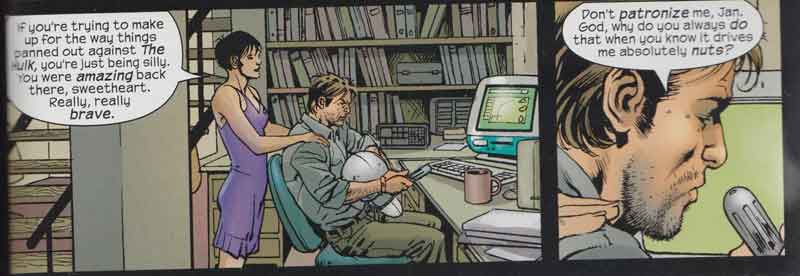 So… Jan tries to help and Hank snaps at her; she tells him not to be horrible; he abuses her with personal (and humiliating) details about her mutant physiology; the tone rises as she points out how happy he was to use her physiology to create his Giant-man formula, and from there things really degenerate until the screaming match ends with Hank hitting his wife. As happens frequently in such situations (according to my late social worker of a dad), the violent spouse immediately feels contrite and wants to apologize (not that it will prevent them from doing the same thing again later, but still)… but Jan defends herself and smashes a radio in Hank’s face. She eventually shrinks to Wasp size and uses her sting (something that is strange in hindsight, for we will learn in volume 2 that she can use it while being normal size… I guess she just didn’t want to risk seriously harming her husband, despite her anger). Hanks is however out of control now and sprays her with bug poison, before siccing his ants on her… it’s really gruesome. And then we have an echo of Chapter 2’s title, Big, which was all about contrasting Banner’s feeling of inadequacy compared to Pym’s success (epitomized by his becoming an actual giant). Here Hank shows he suffers from the same image problem as Banner, declaring that Jan shouldn’t have made him feel small. Great writing, here. 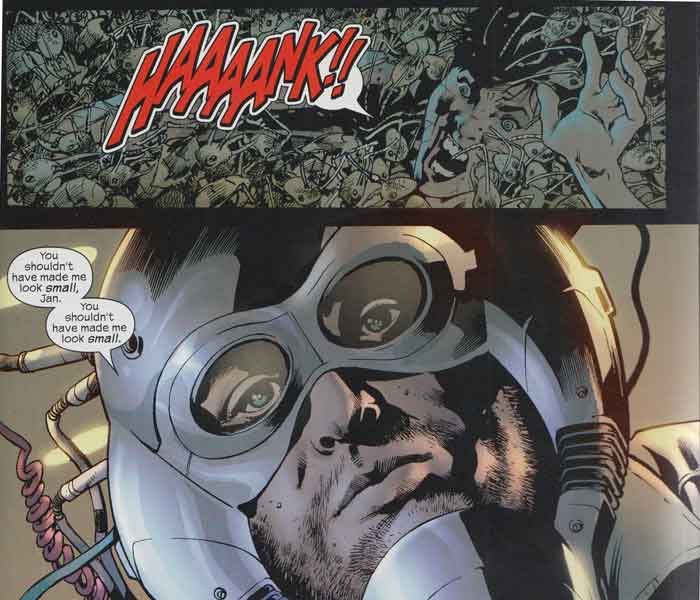 I also love the final page of the book, showing Hank realizing what he’s done after the adrenaline rush passes. I’m convinced his sorrow is genuine, too, and not just a “oh, no, I’m gonna get in trouble for this” attitude… that is often the curse of people whose lack of self-control, whose self-hatred spills out and destroys all they love. Hank is in that sense a tragic figure, and not merely a wife-beater in a stained tank-top. 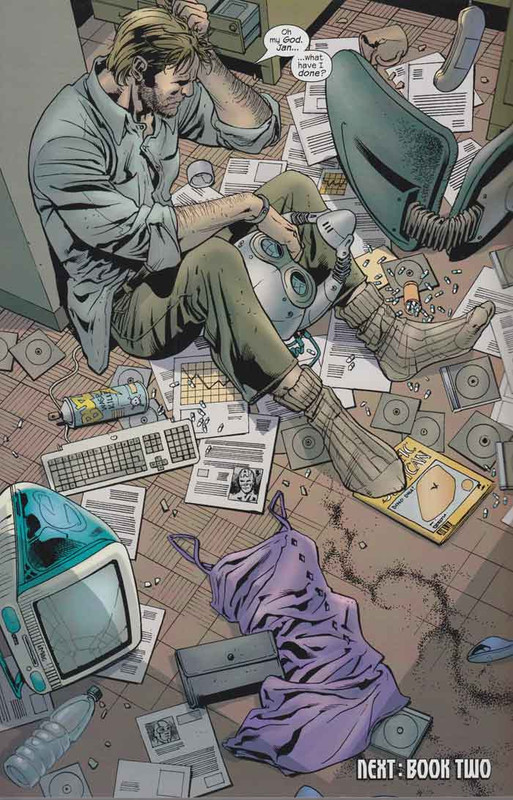 Notes : - rbrman noted earlier that Hank seemed to be left-handed, which would agree with his wearing what looks like a watch on his right wrist. - Cap says his ribs are cracked, his nose broken, and his left arm dislocated… but that he should be good to go in a day or two. Either he’s making a joke (which would really not be in character) or he’s got a pretty good healing factor of his own. - Stark readily admits to be scared of putting on the armor and fighting Hulks. It doesn’t sound like false modesty, although he is clearly able to go beyond his fear. 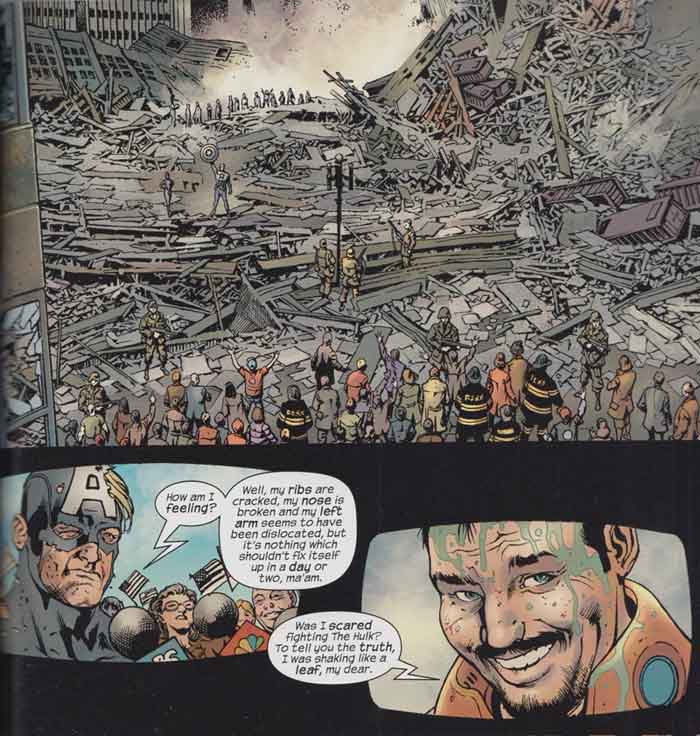 |
|
|
|
Post by codystarbuck on Jul 1, 2019 11:43:36 GMT -5
Millar's abuse makes more sense, based on case histories, than Shooter's slap; but, for me, it far too much a dwelling on the darkest aspects of the psyche and it gets really, vicious. That was off-putting. I don't look for that material in my entertainment. I've encountered enough darkness in real life. It may reflect reality; but, this is escapist entertainment. That is part of why I dropped out of things, in volume 2, until the storyline was collected.
I don't see where you come back with Hank, ater this, without years of therapy, gestures and contrition. I didn't feel that Millar accomplished that by the end of his run and Hank was always a favorite character, which made it worse.
The moments with Cap and Tony, and his helmet were nice.
I will say this comic was very smart in capturing the way the media would deal with this situation and how the heroes would become part of pop culture. Chaykin and Miller were always good with blending that; but, a lot of comics either avoided it or handled it in a cliched manner. This feels more media savvy than most comics.
|
|
|
|
Post by Roquefort Raider on Jul 1, 2019 13:52:41 GMT -5
Millar's abuse makes more sense, based on case histories, than Shooter's slap; but, for me, it far too much a dwelling on the darkest aspects of the psyche and it gets really, vicious. That was off-putting. I don't look for that material in my entertainment. I've encountered enough darkness in real life. It may reflect reality; but, this is escapist entertainment. That is part of why I dropped out of things, in volume 2, until the storyline was collected. That’s fair, but if we must deal with domestic violence I’d rather it be presented in a nauseating way. Well... I don’t think there’s any way for Hank to atone for hs actions, and to go back to a point made earlier, that’s why I like the structure of The Ultimates as a story that seems to be headed for an early conclusion, rather than the basis for a long-term series. Any character, even when based on old fan favourites, can turn out to be a traitor, a complete cad, or be killed off. No need to have some “get out of jail free” card, no need to twist continuity into pretzels so that Hank didn’t really beat Jan because he was replaced by a robot Skrull at the time or was mentally controled by the puppet master; as far as this story goes, he really did it, and that is that. Naturally, that makes his future as a heroic star a somewhat dubious proposition. I also like how the Ultimates quickly shows how superheroes would be weaponized. |
|
|
|
Post by Roquefort Raider on Jul 1, 2019 14:53:30 GMT -5
The Ultimates Volume 1 Story by Mark Millar Art by Bryan Hitch with inks by Paul Neary Andrew Currie, colours by Paul Mounts Chapter seven : Homeland SecurityThe parallel between the Hulk’s rampage in Manhattan and the real-world tragedy of 9/11 is obvious, and the scenes showing how the population mourns are sadly true to life. 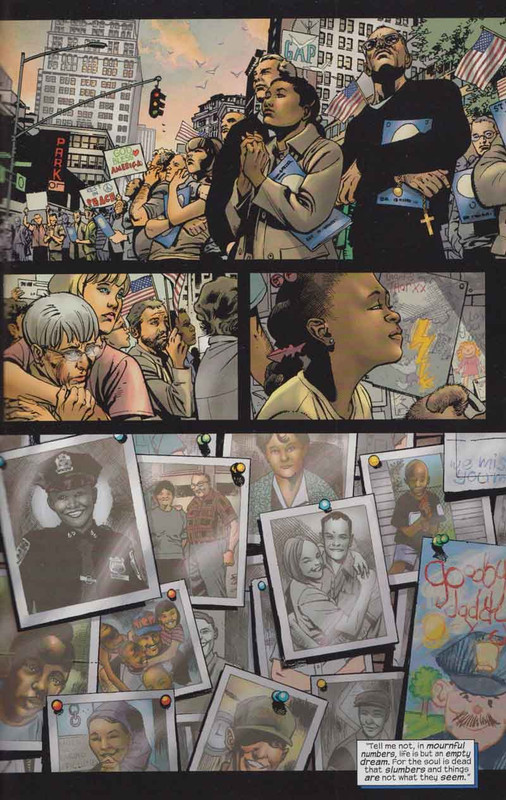 But Banner’s twisted plan worked: approval for the Ultimate program is sky high, as pointed out by Betty Ross (who cynically quips about Fury not being at the memorial ceremony “for the little children” either). This issue sets up the second major story arc of the title, so it is a somewhat quiet one overall. Gail has finally agreed to see Steve again, and she and Bucky provide some emotional support for the time-displaced Cap. Banner is wracked with guilt for the deaths he’s caused, but also relieved to learn that his responsibility isn’t public knowledge and that he won’t be tried for his actions. (While his relief is understandable, it’s also a little off-putting). Jan has survived her fight with Hank but is hospitalized with severa injuries and an anaphylactic shock caused by multiple ant bites. (Pedantically, I’d suggest that she probably suffered a type III hypersensitivity reaction rather than anaphylaxis, because if she had been allergic to ant bites she wouldn’t have been so comfortable with all the ones present in the lab). Hank has disappeared, a wotness having seen him leave home with a duffel bag and wearing a hoodie. Upon discussing what might have happened, the Ultimates learn from Betty (who used to be Jan’s roomie) that the Pym always have had a tempestuous and even violent relationship. The only reason Jan didn’t leave Hank, according to Betty, is that she said “the good times outweighed the bad”. This is again typical of many dysfunctional marriages, alas. Betty also suggests that Jan might not like herself very much, perhaps explaining why she would put up with such treatment. That last point is interesting, because while Jan’s behaviour in the series does not suggest any kind of self-image issue, Cap will later use it during his own argument with the lady. I like the idea that he would recycle someone else’s apparently unfounded explanation because it suits his own narrative. It’s not a big thing, but it makes these characters sound that much more human, that much more fallible. The issue introduces two more members of the program : Black Widow and Hawkeye. They do not do much this time around, but have clearly been involved in Fury’s activities for longer than the rest of the team. Both are described as black ops types. The book concludes as Cap tracks down Hank’s position, in a bar somewhere in Chicago. It is interesting that he does so with so little effort, because it means SHIELD must also know perfectly well where the man is hiding, and for some reason decided not to do anything. Could it be to avoid getting the PR problem worse? After all, a story of domestic violence right on the heels of the Ultimates becoming the public’s darlings sounds very bad. Notes : - Thor apologizes for being late to a meeting by p^retexting he was fighting the Midgard serpent all morning. That sounds like a ridiculous explanation, both in real life and in the comic, and helps maintain the ambiguity about the character. Is he really some kind of supernatural being, or is he a nut with superpowers? |
|
|
|
Post by rberman on Jul 4, 2019 12:11:06 GMT -5
Good comments on chapter six. Two more things: Stark may have been scared by the Hulk, but he's distressingly blase about the outcome of the battle, which we will soon learn killed hundreds of people. But Stark only talks about what a rush it was.  Jarvis talks about getting together with other butlers including Alfred (Pennyworth). Heh.  |
|
|
|
Post by rberman on Jul 4, 2019 12:22:48 GMT -5
The Ultimates Chapter seven : Homeland SecurityJan has survived her fight with Hank but is hospitalized with severa injuries and an anaphylactic shock caused by multiple ant bites. (Pedantically, I’d suggest that she probably suffered a type III hypersensitivity reaction rather than anaphylaxis, because if she had been allergic to ant bites she wouldn’t have been so comfortable with all the ones present in the lab). Great point about the anaphylaxis! Also, Jan hasn't exsanguinated and doesn't need the blood transfusion depicted here, nor do ambulances carry blood.  |
|
|
|
Post by codystarbuck on Jul 4, 2019 14:09:21 GMT -5
The Ultimates Chapter seven : Homeland SecurityJan has survived her fight with Hank but is hospitalized with severa injuries and an anaphylactic shock caused by multiple ant bites. (Pedantically, I’d suggest that she probably suffered a type III hypersensitivity reaction rather than anaphylaxis, because if she had been allergic to ant bites she wouldn’t have been so comfortable with all the ones present in the lab). Great point about the anaphylaxis! Also, Jan hasn't exsanguinated and doesn't need the blood transfusion depicted here, nor do ambulances carry blood.  Probably had battlefield medic images in their heads. |
|